TriMac HexChess
The idea for this game came from a comment on my variant, Fool's Hexagonal Chess, concerning the application of rule 50 to XiangQi in designing an hexagonal variant. More information on the design and rule 50 may be found in the Notes.Star Palace variant (Update: 02-Mar-2007)
After considering suggestions by Abdul-Rahman Sibahi, the palace has been modified and the starting array altered to provide a new default, the Star Palace variant.See under Set-up for further details
Setup
The Board |
|
| This is constructed from 32
regular hexagons, 16 on both sides of the board. Each hexagon is
divided into 6 equilateral triangles
and extra triangles added to smooth the edges and join the two sides. This gives a triangular lattice with 135 intersections or points and a maximum of 12 possible directions of movement from each point. Six of these directions are along the sides of the triangles and are termed orthogonal. They are illustrated in the image on the right by the blue arrows from point A. The other six are through the sides of the triangles and are termed diagonal. See the green arrows from point B. There are two sets of twelve coloured points (red at the bottom, blue at the top) that mark out each player's palace or fortress. The light-coloured horizontal area is called the river and serves as a divide between each player's territory. There are five points (marked by an 'x') termed bridges or bridge-points actually on the river. These are deemed to be in the territory of both players. |
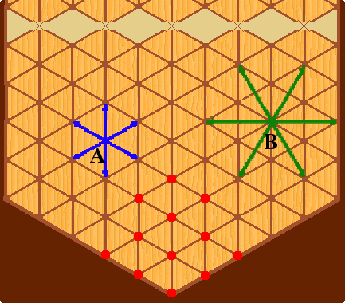 |
Pieces
The pieces are the
same as for XiangQi, but increased in number by 50%. Â So each
player starts the game with 24 pieces comprised of:
See the image on the right for the initial array. |
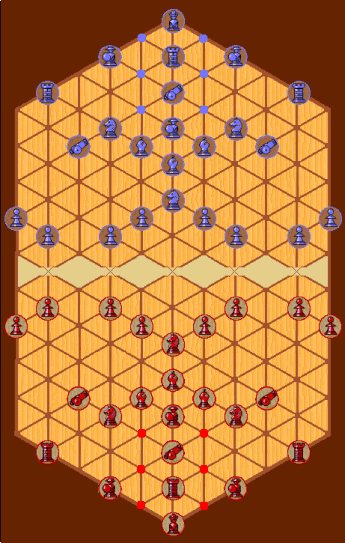 |
||||||||||||||||||||||||||||
Star Palace variant |
|||||||||||||||||||||||||||||
| After considering these
comments the following adjustments were made to produce a new
default variant - The Star Palace variant. 1. The number of points forming a palace was increased from 12 to 14 to meet a Rule 50 target. 2. The shape of the palace was modified so the guards could reach 7 of the points - again meeting a Rule 50 target. 3. The "base" arrangement was to have the back-most row copy the placement used in XiangQi, i.e. Rook, Knight, Bishop, Guard, General, Guard, Bishop, Knight, Rook. 4. The central Guard was then placed one move from the flanking guards and similarly for the middle Bishop. The Guards and Bishops are thus colour-bound, as they are in XiangQi. 5. The central Rook and Knight were left as in the original placement leaving the middle point for the central Cannon. 6. The flanking Guards were then replaced to the front-most points of the palace to unblock the General while still being one move from the central Guard. Here they also act as screens for the central Cannon, now protecting the flanking Cannons which have been moved forward a point from their original placement. 7. The flanking Rooks were also moved outwards by one point to balance the General-Bishop point gap and to defend the central knight and side pawns. 8. Finally the in-board lines joining the palace points were coloured to add emphasis to the palaces. The resulting start array is shown in the image to the right. |
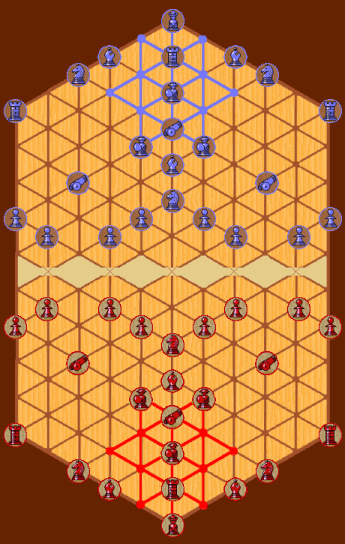 |
||||||||||||||||||||||||||||
Rules
The rules are essentially the same as for XiangQi.ÂThere are two players designated Red and Blue.
A player wins by checkmating the enemy General or stalemating the opponent.
A player loses if they make a move that results in a board position occurring for the third time.
Turns, consisting of moving a single friendly piece, alternate between the players with Red going first.
The movement of each type of piece is summarized in the following section.
Movement |
|
 |
The General is confined to the
fortress and can only move a single orthogonal step at a
time. Generals may not face each other along an open north-south
(vertical) orthogonal. It is thus not permitted to make a move
that leaves the two
generals facing each other with no other piece in between. |
| The Guard must also stay confined
to the fortress, and can only move a diagonal single step. This gives the 2 flanking Guards to the left and right of the General just 5 possible positions, while the central Guard starting on the Palace point nearest the board's centre has only 4. |
|
| The Pawn,
while still in its own territory, can move one step along any of the
three forward facing orthogonals. Once across the central section of
the board (called 'crossing the
river') the Pawn gains the ability to move one step diagonally to the
left or right. The image on the left shows the Pawn's move, the reachable points being marked with black dots for the red Pawn and white for the blue. |
|
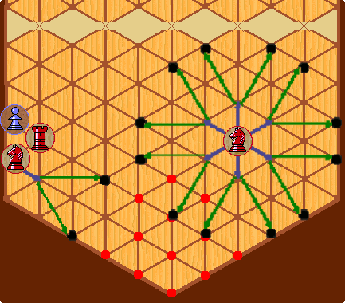 |
The Bishop moves diagonally two steps at
a time. However, bishops cannot jump over other pieces, so a
Bishop is blocked in any direction where another piece is diagonally
next to it. Bishops are defensive pieces and must stay on their
own side of the board. They may occupy a 'bridge' but cannot
cross the 'river' into enemy territory. |
| The Knight
moves by making an orthogonal step followed by a step diagonally
outward. The Knight, however, may not jump over other
pieces. If another piece is orthogonally adjacent to a Knight ,
then
that Knight cannot move in that direction. The Knight's move is shown in the diagram to the left. The innermost red Knight can reach all of the 12 points marked by a black dot, whereas the red Knight at the edge is blocked by the blue Knight and Red Rook and can only reach 2 points as indicated. The route taken by the Knight for each move is shown by the arrows: blue for the initial orthogonal step and green for the final outward diagonal step. |
|
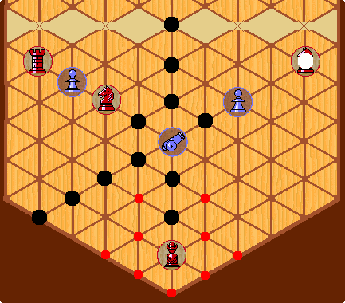 |
The Rook moves like the Rook in western
orthodox Chess, that is, any number of points orthogonally but may not
leap over other pieces. |
| The Cannon,
when not capturing, moves like a Rook, stepping any number of points
orthogonally without leaping over other pieces. The Cannon must, however, leap over another piece (of either side) in order to capture. Thus to capture an enemy piece there has to be a single intervening piece. The Cannon's move is illustrated by the diagram on the left. The blue Cannon may move to the points marked with a black dot or may capture the red Knight marked by a white dot. |
|
Notes
Rule 50
Rule 50 states - "If a numerical representation of an attribute is possible, then this attribute in a hex-based game should exhibit a 50% increase over it's value in that game's square-based counterpart."
Adherence to Rule 50
Game Attribute |
Orthodox XiangQi Value
|
Rule 50 Target Value |
TriMac variant |
|
Value |
Score |
|||
| Points |
90 |
135 |
135 |
3 |
| Pieces per
side |
16 |
24 |
24 |
3 |
| Pawns per
side |
5 |
7 or 8 |
8 |
3 |
| Knights per side | 2 |
3 |
3 |
3 |
| Â Bishops per side | 2 |
3 |
3 |
3 |
| Rooks per side | 2 |
3 |
3 |
3 |
| Cannons per
side |
2 |
3 |
3 |
3 |
| Guards per
side |
2 |
3 |
3 |
3 |
| Generals per side | 1 |
1 or 2 |
1 |
3 |
| Pieces per
side able to make move at start |
16 |
24 |
24 |
3 |
| Points
reachable at start |
27 |
40 or 41 |
51 |
0 |
TriMac Rule 50 score = 91%.
Variant Name
In some ways choosing a name can be the hardest part of any variant design. The names originally considered for this variant were "Hexagonal XiangQi" , "Hexagonal Chinese Chess", "LiuJiao XiangQi" and "六角 象棋". All four have the same meaning, my favourite being "LiuJiao XiangQi": but I eventually rejected it as being rather presumptuous on my part. I had, and still have, no way of knowing if an hexagonal variant already exists - my Chinese is nowhere near good enough to conduct a proper search of the extensive online information in that language. I also considered "Tholian Web Chess" but did not want to infringe any possible Paramount copyright.So I eventually settled for the perhaps obscure "TriMac HexChess". "HexChess" identifies it as an hexagonal variant, while "TriMac" is a contraction of the Latin "triquetra macula" meaning "three-cornered mesh" which refers to the game board's triangular lattice playing area.
 This 'user submitted' page is a collaboration between the posting user and the Chess Variant Pages. Registered contributors to the Chess Variant Pages have the ability to post their own works, subject to review and editing by the Chess Variant Pages Editorial Staff.
This 'user submitted' page is a collaboration between the posting user and the Chess Variant Pages. Registered contributors to the Chess Variant Pages have the ability to post their own works, subject to review and editing by the Chess Variant Pages Editorial Staff.
By Graeme C Neatham.
Web page created: 2007-02-08. Web page last updated: 2007-02-08













